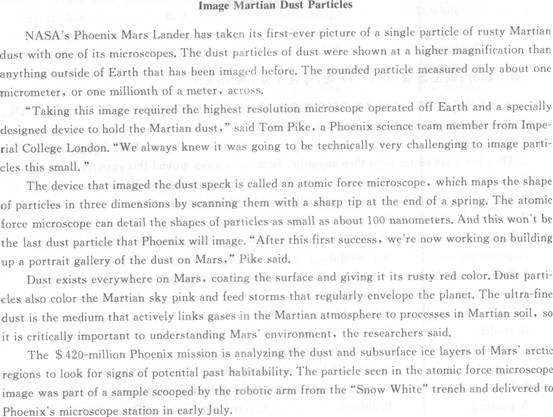 题目内容
(请给出正确答案)
题目内容
(请给出正确答案)
elementary particle基本颗粒
 答案
答案
 请输入或粘贴题目内容
搜题
请输入或粘贴题目内容
搜题
 拍照、语音搜题,请扫码下载APP
拍照、语音搜题,请扫码下载APP
 题目内容
(请给出正确答案)
题目内容
(请给出正确答案)
 答案
答案
 更多“elementary particle基本颗粒”相关的问题
更多“elementary particle基本颗粒”相关的问题
第1题
A.although
B.though
C.since
D.because
第2题
One might expect that the vacuum would always be the state of lowest possible energy for a given region of space. If an area is initially empty and a real particle is put into it, the total energy, it seems, should be raised by at least the energy equivalent of the mass of the added particle. A surprising result of some recent theoretical investigations is that this assumption is not invariably tree. There are conditions under which the introduction of a real particle of finite mass into an empty region of space can reduce the total energy. If the reduction in energy is great enough, an electron and a positron will be instantly created. Under these conditions the electron and positron are not a result of vacuum fluctuations but are real particles, which exist indefinitely and can be detected. In other words, under these conditions the vacuum is an unstable state and can decay(衰)into a state of lower energy; that is one in which real particles are created.
The necessary condition for the decay of the vacuum is the presence of an intense electric field. As a result of the decay of the vacuum, the space permeated by such a field can be said to obtain an electric charge, and it can be called a charged vacuum. The particles that materialize in the space make the charge vacuum is likely to be found in only one place: in the immediate vicinity of a super heavy atomic nucleus(原子核) ,one with about twice as many protons as the heaviest natural nuclei known. A nucleus that large cannot be stable, but it might be possible to assemble one next to a vacuum for long enough to observe the decay of the vacuum. Experiments attempting to achieve this are now under way.
Which of the following titles best describes the passage as a whole?
A.The Vacuum: Its Fluctuations and Decay.
B.The Vacuum: Its Creation and Instability.
C.The Vacuum: A state of Absence.
D.Particles That materialize in the Vacuum.
第3题
One might expect that the vacuum would always be the state of the lowest possible energy for a given region of space. If an area is initially empty and a real panicle is put into it, the total energy, it seems, should be raised by at least the energy equivalent of the mass of the added panicle. A surprising result of some recent theoretical investigations is that this assumption is not invariably true. There are conditions under which the introduction of a real particle of finite mass into an empty region of space can reduce the total energy, If the reduction in energy is great enough, an electron and a positron will be instantly created. Under these conditions the electron and positron are not a result of vacuum fluctuations but are real particles, which exist indefinitely and can be detected. In other words, under these conditions the vacuum is an unstable state and can decay(衰减) into a state of lower energy; that is one in which real particles are created.
The necessary condition for the decay of the vacuum is the presence of an intense electric field. As a result of the decay of the vacuum, the space permeated by such a field can be said to obtain an electric charge, and it can be called a charged vacuum. The particles that materialize in space make the charged vacuum likely to be found in only one place: in the immediate vicinity of a super heavy atomic nucleus(原子核), one with about twice as many pro tons as the heaviest natural nuclei known. A nucleus that large cannot be stable, but it might be possible to assemble one next to a vacuum for long enough to observe the decay of the vacuum. Experiments attempting to achieve this are now under way.
Which of the following titles best describes the passage as a whole?
A.The Vacuum: Its Fluctuations and Decay.
B.The Vacuum: Its Creation and Instability.
C.The Vacuum: a State of Absence.
D.Particles that Materialize in the Vacuum.
第8题
根据以下资料,回答{TSE}题。 {TS}The dust particle on Mars is the smallest particle that has been imaged outside of Earth.
{TS}The dust particle on Mars is the smallest particle that has been imaged outside of Earth.
A. Right
B. Wrong
C. Not mentioned